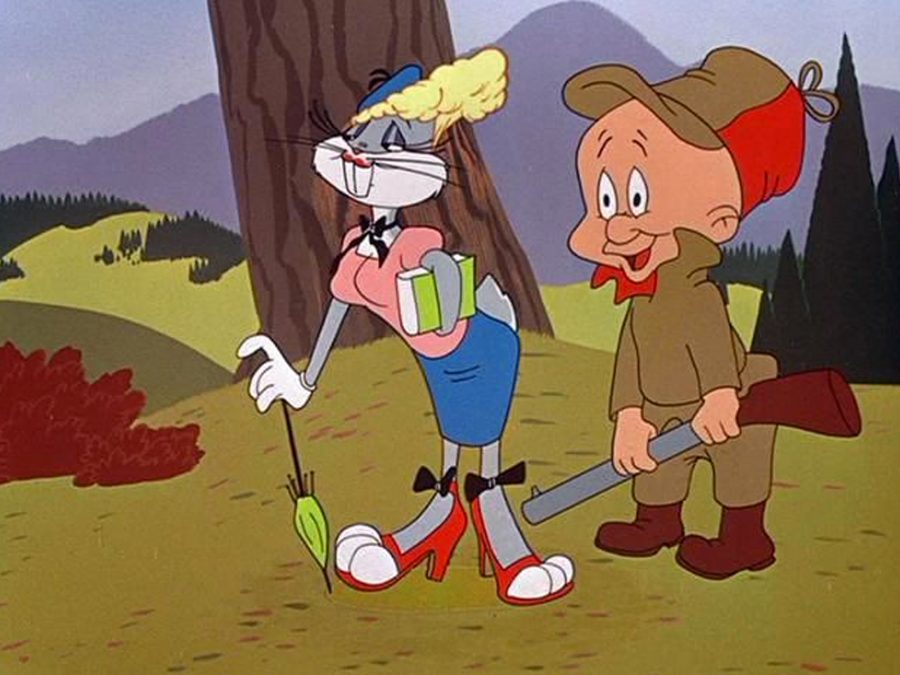Even though he wouldn’t have been thought of as such at the height of his fame, Bugs Bunny was, for a long time, the most famous gender-nonconforming character in the world. Even today he still ranks among them, but despite the countless times he’s cross-dressed or kissed another man on the lips, it’s not so easy to talk about Bugs as a queer icon.
In fact, it’s hard to say anything definitive about the Looney Tunes (or its interchangeable sister series Merrie Melodies), as the shorts were animated over many years by directors of strong and divergent points of view. These creatives weren’t necessarily in close contact, and they certainly weren’t interested in continuity beyond the broadest strokes of a character. They had a shared attitude, but it was one of irony and insincerity.
After the release of Snow White it became obvious that no one could keep up with Disney on their terms, so the Warner Bros. cartoon studio set themselves against them. While Disney tried to give their characters and stories emotional weight, the Looney Tunes often ended by breaking whatever thin logic they’d established – like in Falling Hare (1943, Robert Clampett) where a nose-diving plane stops just before smashing into the ground because it “ran out of gas” – as if to laugh at anyone who would take a cartoon seriously. It’s that contempt for convention (and the defence of irony meaning that everything was just a gag) that allowed Bugs to show so much queerness in such unaccommodating times.
Most major Looney Tunes characters have cross-dressed since the series is directly influenced by vaudeville, where it’s a major comedic trope, but few took to it as quickly as Bugs. In his third appearance, Hare-Um Scare-Um (1939, Ben Hardaway & Cal Dalton) – before he had a name, only a personality copied from the recently successful Daffy Duck – he dresses as a female dog to trick a hunter’s pet. But, to some extent, the joke is at Bugs’ expense: the costume is ill-fitting, it looks quite bizarre and even a little scary.
The idea was refined a few years later, after Bugs’ ‘official’ debut in A Wild Hare (1940, Tex Avery) but before Mel Blanc had totally settled on a voice, in Elmer’s Pet Rabbit (1941, Chuck Jones). When Bugs dances with his owner and primary nemesis Elmer Fudd, fluttering his eyelashes and speaking in a Katherine Hepburn-esque voice, we are invited to enjoy – and maybe even identify with – his chaotic and joyful performance of femininity.
Gender expression isn’t presented like this with any other character in the series: when Daffy pulls down his feathers like a dress in The Wise Quacking Duck (1943, Clampett) he looks silly and wacky, and when a predatory wolf dresses in female sheep’s clothing in I Got Plenty of Mutton (1944, Frank Tashlin) he’s animated to look as grotesque and aberrant as possible putting on lipstick. But once Bugs is both acting and dressing feminine at the same time, shortly after Elmer’s Pet Rabbit, he looks good; his stylish outfits cling tightly to his curves.
It’s no surprise that in a famous scene from Wayne’s World (1992) Garth admits to being attracted to him, Wayne seems to agree, as his defensive laugh tries a little too hard to hide. Even when Bugs is caught and his enemies realise that it’s him in those outfits, they are removed entirely rather than broken. The image isn’t shattered, attention isn’t drawn to its construction and artifice, like it is for Wile E. Coyote in Going! Going! Gosh (1952, Jones), who lays defeated with one breast out of place.

The heart of this difference goes back to Elmer’s Pet Rabbit, when a bowl of vegetables is dropped into Bugs’ hutch and he screams: “What do you think I am? A rabbit?”. Bugs is liminal, he exists between species as he does between genders (that’s why a suit on him feels as much like ‘drag’ as a dress). This is canonised in What’s Up, Doc? (1950, Robert McKimson) when he tells his Hollywood backstory to a journalist: he always knew that he was different, he says, he was “a rabbit born into a human world”. He comes desperately close to explicitly describing such a fundamentally queer experience – that feeling of being an outsider to the straight world. But what makes Bugs exciting and empowering is that he turns his lack of belonging into a strength; crossing between the boundaries of gender gives him not only personal pleasure, but also a unique power.
When Bugs kisses his adversaries, other men, on the lips (which, in more hetero-normative times would have been associated with cross-dressing) or when he allures them with a tight fitting dress, he isn’t attacking their sexuality, he’s expanding it. He reveals to them that their desires are bigger than their ideas, that the boundaries of attraction, and the boundaries of gender, are arbitrarily drawn; in Rabbit of Seville (1950, Jones) Bugs doesn’t snap Elmer’s gun in half, he ties it into a knot.
These aren’t simply tricks, only performances for the sake of besting someone, because in To Hare is Human (1956, Jones) and Backwoods Bunny (1959, McKimson) Bugs dresses femininely in the privacy of his own home, only for himself. Yet the tactic does work particularly well to fool not just those as foolish as Elmer, but the kind of stuffy patriarchal elitists that would be most invested in upholding the standards of gender. Like the pompous opera singer in Long-Haired Hare (1949, Jones) or the murderous department store manager / taxidermist in Hare Conditioned (1945, Jones).
As strong and useful as these queer resonances are, they should be looked at in context, because the very spirit of transgression and sense of disregard that allowed them also led to some of the ugliest and most offensive shorts of the era when those targeted were not the people in positions of power, but were instead those furthest below. Some of these shorts, which tended to target Black, Asian or Native American people, were commissioned by the US government for the war effort, but many weren’t. The series as a whole can’t be taken into the modern day without some serious disclaimers, and there’s a case to be made that it doesn’t deserve to.
But the value in doing so can be seen as early as 2003 in Joe Dante’s Looney Tunes: Back in Action, when a studio executive warns Bugs that “the cross-dressing thing” was funny in the past, but today is “disturbing”. Now that Bugs’ queerness necessarily connects to real, visible queer people, it is newly threatening to those in power, and so newly powerful against them.
In Rabbit Seasoning (1952, Jones) Bugs pulls a women’s sweater over his head. At the time it might have seemed a strange in-between moment, a space where a joke should have been, but now it shows clearly the process of gender expression; it shows it as an act, as something you can do. This isn’t just a coincidence or projection, even though Chuck Jones denied the connection, in a 1996 interview with Mark Thompson and Brian Phelps where he said that “it was just funny” and that no one even knew the “term” for transgender people.
Queerness existed long before there were words to describe it, and whether through contemporary queer art or a group of nominally straight cis men making cartoons in the mid-twentieth century, will always find a way out. It will always be there, because we have always been there, and always will be.
The post Why I love the queerness of Bugs Bunny appeared first on Little White Lies.
from Little White Lies https://ift.tt/Wc9SjTN



0 Comments